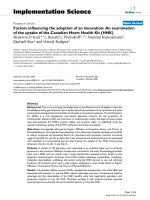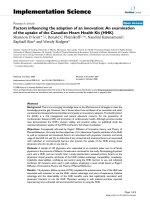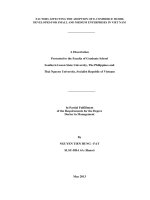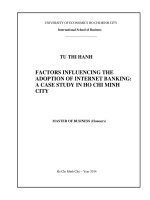Factors responsible for adoption of Gobindabhog rice in some selected areas of Burdwan district, West Bengal, India
Bạn đang xem bản rút gọn của tài liệu. Xem và tải ngay bản đầy đủ của tài liệu tại đây (241.63 KB, 7 trang )
Int.J.Curr.Microbiol.App.Sci (2019) 8(2): 107-113
International Journal of Current Microbiology and Applied Sciences
ISSN: 2319-7706 Volume 8 Number 02 (2019)
Journal homepage:
Original Research Article
/>
Factors Responsible for Adoption of Gobindabhog Rice in Some Selected
Areas of Burdwan District, West Bengal, India
Chowdhury Nazmul Haque*, Dinesh Das Kaibartya and Arup Kumar Bandyopadhyay
Department of Agricultural Extension, Bidhan Chandra KrishiViswavidyalaya,
Mohanpur, Nadia, West Bengal, India
*Corresponding author
ABSTRACT
Keywords
Adoption, Aromatic
rice, Gobindabhog
Article Info
Accepted:
04 January 2019
Available Online:
10 February 2019
Adoption is a process of making a decision about an innovation of technology option
offered to anyone. Even though we have brought about green revolution and moving for
second green revolution, more than 60% of technology cannot reach the domain of
farmer‟s innovation decision. So the present study takes care of adoption process of
„Gobindabhog‟ famous traditional aromatic rice, to explore the process and complexity of
its adoption and subsequent socialization. Aromatic rice like Gobindabhog has got social,
ecological and economic importance. The general objective is estimating the factors
responsible for adoption of Gobindabhog rice and following are the specific objectives: -1.
To find out the relationship of the selected independent variables with the adoption
behaviour of the farmers engaged in „Gobindabhog‟ rice cultivation. 2. To identify the
degree to which the adoption behaviour may be predicted from this characteristics. 3. To
access the different problems faced by the farmers hindering the adoption process and the
measures suggested by them as remedies. The important relevation of the study depicts
that the following independent variables i.e. Age (X1), Caste (X2), Family type (X3),
Family size (X4), Education (X5) Area under „Gobindabhog‟ rice cultivation(X6), Land
(X7), House (X8), Farm power (X9), Material possession (X10), Annual Income (X11),
Social Participation (X12), Attitude towards „Gobindabhog‟ rice cultivation (X13),
Knowledge about „Gobindabhog‟ Rice cultivation(X14), Market Orientation (X15),
Production Orientation (X16), Risk Orientation (X17), Economic Motivation (X18),
Innovation Proneness (X19), Massmedia exposure (X20), Personal Cosmopolite (X21),
Personal Localite (X22) have got distinct contribution to the dependent variable i.e.
Adoption of Gobindabhog rice cultivation. Analyzing the data using the statistical tools
correlation of coefficient and multiple regression documented results were obtained.
gained wider acceptance in Europe and the
United States. Because of their aroma, flavour
and texture, aromatic varieties command a
higher price in the rice market than do the
non-aromatic rice varieties. Scented or
aromatic rice are nature‟s gift to the Indian
Introduction
Rice is a major food commodity throughout
the world. Different cultures have preference
for different types of rice. Scented rice or
aromatic rice is popular in Asia and has
107
Int.J.Curr.Microbiol.App.Sci (2019) 8(2): 107-113
sub-continent and human kind at large.
Compared to other classes of rice aromatic
rice is highly demanded and get better
premium in global market due to its pleasant
aroma, superfine long slender grains with
delicate
curvature,
remarkable
linear
elongation and excellent flaky soft texture on
cooking. With the growing demand for these
3 quality rice in international market, high
emphasis has been placed for the
improvement of basmati types. The longgrained basmati rice generally exported and
has assured markets, while the small and
medium grained aromatic rice being regarded
as a separate class of non-basmati aromatic
rice has limited popularity. These indigenous
varieties blessed with some of the outstanding
qualities like very strong aroma, kernel
elongation after cooking, fluffiness and taste
and are quite popular in their native areas of
cultivation and possess a domestic market
value.
aromatic rice germplasm is left. Although the
production of aromatic rice per unit area is
lower than the ordinary rice but the farmers
are getting more price than ordinary rice and
there is assured market of their produce in the
state, only for this reason the farmers are
showing interest regarding the cultivation of
aromatic rice and the area under aromatic rice
is increasing day by day. The „Gobindabhog‟
rice is a very special cultivar from West
Bengal, it is a short grain with white aromatic
rice that is used for any special occasion or to
offer „Bhog‟ to the deity. Many traditional
Bengali dishes are prepared with this aromatic
Gobindabhog rice. Bengalis are connected
with Gobindabhog rice forever, it is their
birthright to find Gobindabhog rice and make
any kind of dishes, any time they want.
The Government of West Bengal has created
a great opportunity for the rice lovers, to find
their favorite rice delivered right at their
doorstep all over the world. The Bengalis as
well as the non-Bengalis can now obtain the
pleasure of having Gobindabhog rice recipies
like; Bengali khichuri, Payesh (a sweet dish),
Pulao and many more.Gobindabhog rice was
generally being cultivated in Bardhaman,
Hoogly, Nadia and Bhirbhum but now it has
been intensifying into various other states in
India. The rice cultivation is also one of the
major job opportunity in India as well.
In West Bengal situation paddy is the main
principle crop where all the farmers are
habituated with paddy cultivation not only for
their family consumption but also for
commercial purpose. They are cultivating
both traditional and high yielding variety on a
commercial basis. Low-yielding aromatic
rices have been the major casualty of green
revolution where the main emphasis was on
yield rather than quality. A large number of
aromatic rices have already been lost and
many are at the verge of extinction. It is more
true for the small and medium-grained
aromatic rices which are mostly cultivated for
home consumption than the long-grained
Basmati types which form the bulk of rice
export. Some of the small and mediumgrained aromatic rices possess excellent
aroma and other quality traits like kernel
elongation after cooking, taste etc. These
could be excellent sources for improving
quality in high yielding varieties. Therefore,
there is a strong need to conserve whatever
The Gobindabhog rice cultivation played a
major role in the agricultural market. The
whole rice-growing industry was changed and
got a lot of popularity over the world. Every
Bengali has an irresistible taste and flavor for
Gobindabhog rice and no one can go wrong
with it. One of the main features of
Gobindabhog rice is that, it can go amazingly
well with anything, and also it can be
prepared by just mixing with any kind of
spices. This brilliant form of rice is most
popular Bengali dish, and conjures happy
thoughts among people.
108
Int.J.Curr.Microbiol.App.Sci (2019) 8(2): 107-113
regression analysis were
interpretation of the result.
Materials and Methods
Two blocks under the subdivision of
BurdwanSadar South, Burdwan District of
West Bengal namely Khandaghosh (consists
of 10 gram panchayats) and Raina-1 (consists
of 8 gram panchayats) were purposively
selected for the study. From these two blocks
one gram panchayat from each block was then
purposively selected (where Gobindabhog
rice cultivation is highly adopted) namely
Lodna (Khandaghosh block) and Nadugram
(Raina-1 block). And finally from this two
gram panchayats one village from each i.e.
Barishali (Lodna Gram Panchayat) and
Nandal (Nadugram Gram Panchayat) were
selected. From these two villages 50 (25 from
each) Gobindabhog rice growers, who were
cultivating Gobindabhog rice in their own
field or having tenancy status were finally
selected purposively as respondents for the
study.
applied
for
Results and Discussion
Table 1 represent the correlation co-efficient
between the dependent variable adoption of
„Gobindabhog‟ rice cultivation and 22 other
independent variables.
According to the simple correlation i.e.
Pearson correlation it was found that the
variables except caste(X2), family type(X3),
family size(X4), farm power (X9), material
possession (X10), social participation (X12),
knowledge level (X14), production orientation
(X16), innovation proneness (X19), the other
13 independent variables had been found
significant relationship with the dependent
variable i.e. adoption of „Gobindabhog‟ rice.
These 9 independent variables had not any
significant correlation with the dependent
variable.
Adoption behaviour of Gobindabhogrice
grower was considered as dependent variable
and other variables were categorised in three
different factors namely socio-economic
factor which includes the variable age, caste,
family type, family size, education, area under
cultivation, land holding, house type, farm
power,
material
possession,
sociopsychological factor includes the variable
annual income, social participation, attitude
towards aromatic rice cultivation, knowledge
level,
market
orientation,
production
orientation, risk orientation, economic
motivation, innovation proneness and
extension communication factor includes the
variable mass media exposure, personal
cosmopolite and personal localite were taken
as independent variables in this study.
In this analysis it was found that the age (X1)
of the respondent was negatively significant
at 0.05 level of probability with the adoption
behaviour of the Gobindabhog rice growers.
This indicates that the younger generation of
the farmers was interested in growing
Gobindabhog rice in their field more than the
older farmers.
The
independent
variable
market
orientation(X15) was positively significant at
0.05 level of probability with the adoption
behaviour i.e. person with higher market
orientation are interested in adoption of
Gobindabhog rice.
The independent variables education (X5) and
house type (X8) were positively significant at
0.05 level.
Data were collected by interviewing the
respondents personally with the help of a
well-structured pre-tested interview schedule.
Correlation co-efficient analysis and multiple
The other 9 independent variables i.e. area
under aromatic rice cultivation (X6), land
109
Int.J.Curr.Microbiol.App.Sci (2019) 8(2): 107-113
(X7), annual income(X11), attitude towards
„Gobindabhog‟ rice cultivation (X13), risk
orientation(X17), economic motivation (X18),
mass media exposure (X20), personal
cosmopolite (X21), personal localite (X22) was
positively significant at 0.01 level of
probability with the adoption behaviour of
Gobindabhog rice growers. Thus it can be
inferred that the respondents with higher
degree of these variables are more interested
in adoption of Gobindabhog rice in their field
situation.
the recent diffusion innovation studies caste
was not important factors for adoption of any
technology.
According to Spearman correlation it was
found
that
the
variables
except
caste(X2),family type(X3), family size(X4)
farm power(X9), material possession(X10),
social participation (X12) knowledge level of
farmer(X14), production orientation(X16),
innovation proneness(X19), the other 13
independent
variables
have
recorded
significant relationship with the dependent
variable adoption of Gobindabhog rice. These
9 independent variables had not any
significant correlation with the dependent
variable.
It was revealed in the study from the results
that attitude towards Gobindabhog rice
cultivation, market orientation(X15), risk
orientation, economic motivation(X18) were
variables of socio-psychological dimension
which had gone together to build up a strong
entrepreneurial motivation, which in turns
steer the respondents for adoption of
Gobindabhog rice at a substantial level. These
variables have further established themselves
to be positively and significantly correlated.
The variables land holding, annual income,
area under Gobindabhog rice cultivation
which is the characteristics of one‟s sociopersonal
dimension
went
positively
significant with the adoption behaviour of the
cultivars. These are the indicators of social
prestige, esteem and status of an individual in
the social system.
Table 2 represents the step wise multiple
regression between the dependent variable
adoption of Gobindabhog rice cultivation and
the other 22 independent variables. In this
table the unstandardized regression coefficient („b‟ value), the standard error of b
(SE of b), the standardized partial regression
co-efficient (β value),„t‟ values, the standard
error of intercept, the co-efficient multiple
regression determination (R2) and the adjacent
R2 values are presented.
So it was found the mass media exposure, the
personal cosmopolite and personal localite is
positively significant with the adoption.
Social participation is one of the important
factors which help the farmer to adopt the
modern practices. Generally the farmers
having more social participation is likely to
have higher adoption rate but in our study we
found that there was no significant
relationship with the dependent variable i.e.
adoption of Gobindabhog rice that means the
farmers who have adopted rice production
technology in the 2 villages they were only
maintaining relationship with some experts.
It was found that the independent variables
Area under cultivation (X6), Age (X1) and
Economic motivation (X18) had been retained
after eliminating the other trivial variables in
the preceding steps.
It was also found that caste was not
significant to the adoption of Gobindabhog
variety of rice. It may be assumed that from
The table depicted that the variable Area
under cultivation (X6) recorded highest
regression effect on the extent of adoption
110
Int.J.Curr.Microbiol.App.Sci (2019) 8(2): 107-113
having the β value of 0.588.Thus it had an
positive effect on the adoption level. It was
also observable that a unit change in this
variable had contributed 1.850 unit changes in
the adoption level which is also the highest
contribution of all.
the adoption level. On the other hand the
variable Age (X1) recorded the regression
effect on the extent of adoption having the β
value of -0.159, thus representing a negative
effect on the adoption level and with the unit
change in this variable had contributed 0.159
unit changes (negatively). Here the R2 value
being 0.643, it is to infer that the 3 variables
together explain 64.30% variation embedded
with the predicted variable of adoption of
Gobindabhog rice cultivation.
The variable Economic motivation (X18) also
had a positive effect on adoption exhibiting
the β value of 0.240. A unit change in this
variable had contributed 1.169 unit changes in
Table.1 Correlation Co-efficient between Adoption behaviour of Gobindabhog Rice cultivars
and rest 22 independent variables
Variables
Age (X1)
Caste (X2)
Family type (X3)
Family size (X4)
Education (X5)
Area under cultivation (X6)
Land (X7)
House (X8)
Farm power (X9)
Material Possession (X10)
Annual Income (X11)
Social Participation (X12)
Attitude towards Gobindabhogrice
cultivation (X13)
Knowledge Level (X14)
Market Orientation (X15)
Production Orientation (X16)
Risk Orientation (X17)
Economic Motivation (X18)
Innovation Proneness (X19)
Mass media exposure (X20)
Personal Cosmopolite (X21)
Personal localite (X22)
Note: ** = Significant at 0.01 level of probability
* = Significant at 0.05 level of probability.
111
‘r’ value
(Pearson)
‘ ’ value
(Spearman)
-0.305*
-0.135
0.094
0.031
0.314*
0.719**
0.475**
0.311*
0.092
0.178
0.465**
0.164
0.486**
-0.306*
-0.160
0.095
0.044
0.321*
0.738**
0.393**
0.284*
0.040
0.201
0.437**
0.135
0.547**
0.072
0.317*
0.119
0.554**
0.580**
0.182
0.473**
0.459**
0.472**
0.047
0.309*
0.162
0.598**
0.599**
0.127
0.474**
0.446**
0.479**
Int.J.Curr.Microbiol.App.Sci (2019) 8(2): 107-113
Table.2 Multiple Regression analysis (By Stepwise Method of Multiple Regression Equation) of
the Adoption Behaviour (Y) with the other 22 causal variables
Variables
Unstandardized
Co-efficient
‘ b’
value
Standardized
Co-efficient
Standard
error
„b‟
β
‘t’
value
of
Adoption (Y)
(constant)
57.611
4.170
Area under
cultivation (X6)
1.850
0.325
0.588
5.687**
Age (X1)
-0.159
0.054
-0.263
2.960**
Economic
motivation (X18)
1.169
0.507
0.240
13.816
2.307*
Standard Error of intercept = 3.238; R= 0.802; R 2 = 0.643; Adjacent R2 = 0.619
Note: ** = Significant at 0.01 level of probability
* = Significant at 0.05 level of probability
Adoption process is a complex, multifaceted
and polymorphous while we keep on
contemplating its qualitative expansion
through the domain of behavioural
disposition, especially for the farming
community. The expression of effectional
discourses that is attitude and motivation has
been attuned to a complex parametric
disposition
consisting
of
resources,
institution, organization, market etc. The
other non-parametric disposition has been the
discrete psychological deposition and its
acquisition to technology adoption the key
content of the study. The present study has
been resultants through an estimation of
variable interaction and its factorial
configuration. It can be concluded from the
study that Area under cultivation (X6) as a
resource is still a unique characteristic to
impact on adoption process. Economic
motivation, as a tiny social echelon has
characterised the process of adopting aromatic
rice Age has been catalytic and characteristic
with the process of adoption especially in
„Gobindabhog‟ rice. Any adoption process is
basically a heterophylic exposition of socio
economic and technological interaction which
has wellbeing networked in the given study.
The adoption process as studies under this
heuristic research has been not that unique so
far to estimate the process as unique with
Gobindabhog rice. So scopes are there to
identify and elucidate whether adoption
process of Gobindabhog rice can present a
unique process over the gross generalization
occurring in the general adoption behaviour.
112
Int.J.Curr.Microbiol.App.Sci (2019) 8(2): 107-113
Rajasthan. Agric. Update., 7: 376-80.
Thawait, D., Kar, S. and Patel, A.K. 2014.
Agronomic evaluation of scented rice
(Oryza sativa L.) under different
planting patterns. J. Crop Weed,
10:175-78.
Adhikari et al., 2011 At present, only 12-15
indigenous aromatic rice varieties
(IARVs) are being cultivated in some
scattered pockets of different districts in
West Bengal in an unorganized manner
Deb (2005) in his famous book, entitled,
“Seeds of Tradition, Seeds of Future”
provided
detailed
morphological
descriptions of 416 Indian indigenous
rice varieties
Ghosh et al., (1995) stated that The local
variety Gobindabhog, with small, fine,
scented grain, was improved by
induction of semidwarf mutants
Hasib et al., (2004) postulated three induced
mutants of local aromatic tall indica
cultivars Tulaipanja (IET 14142 and
IET 14143) and Gobindabhog (IET*
IET *13541) were crossed with 2
Basmati cultivars (Basmati 370 and
Pakistan Basmati) to develop highyielding cultivars with Basmati-type
grain quality suitable for cultivation in
eastern India
Kole (2005) Sated in Journal-of-Geneticsand-Breeding that Inheritance of plant
height in five gamma -ray induced
mutants of aromatic rice cultivar
'Gobindabhog' was studied through 6x6
diallele cross and segregation analyses.
References
Adhikari, B., Bhowmick, M.K. and Bhadra,
K.K. 2013. Sugandhi dhanerchas, adhik
laver aswas (in Bengali). Saar
Samachar, 51: 22-28.
Adhikari, B., Bhowmick, M.K., Halder, A.
and
De,
S.
2011.
Paschimbangeamanmorsumeysugandhi
dhanerchas
(in
Bengali).
Saar
Samachar, 49: 33-39.
Anonymous 2012. Promotion of Bengal
aromatic rice through improved
production and processing system. In.
BCKV Newsletter (Ed. Brahmachari,
K.),
Bidhan
Chandra
Krishi
Viswavidyalaya, West Bengal, 6: 2.
Ghoshal, R., Garai, S. and Mazumder, G.
2010.Adoption of improved fish
cultivation practices among the fish
farmers of Uttar Dinajpur district of
West Bengal. Env. Eco., 28: 2104-06.
Mehta, B.M. and Sonawane, M. 2012.
Entrepreneurial behaviour of mango
growers of Valsad District of Gujarat
state. Indian Res. J. Extn. Edu., 12: 7882.
Mote, T.S. and Wadnerkar, D.W. 2009.A
study on knowledge and adoption of
soybean production technology among
the farmers in Hingoli district of
Maharashtra. Agric. Update., 4: 229-32.
Sharma, K.C., Singh, P. and Panwar, P.
2012.Association of personal attributes
with knowledge and adoption regarding
maize
production
in
Bhilwara
How to cite this article:
Chowdhury Nazmul Haque, Dinesh Das Kaibartya and Arup Kumar Bandyopadhyay. 2019.
Factors Responsible for Adoption of Gobindabhog Rice in Some Selected Areas of Burdwan
District, West Bengal, India. Int.J.Curr.Microbiol.App.Sci. 8(02): 107-113.
doi: />
113









